The Beauty of elusive Architecture –António Ole's exhibition “In the skin of the city”
Location isn’t a prison;
it’s comprised of material,
but unfinished maps and histories.
James Clifford
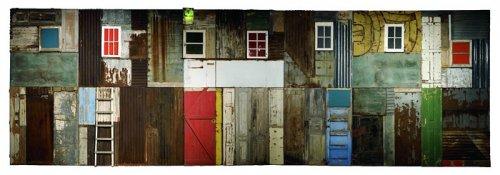 'Township Wall', Culturgest, Lisbon, 2003
'Township Wall', Culturgest, Lisbon, 2003
In his new exhibition project In the skin of the city (Na pele da cidade) António Ole talks about space. It is about his hometown Luanda, but could be any other city as well. A place, where he stopped on one of his many travels, to absorb it’s particularity. To absorb and let it be inscribed into his very own skin. In the past years he has seen many places during his travels for various exhibitions in the international art-world. To mention just a few recent ones, he has been to Washington (Artists in Dialogue, National Museum of African Art, Smithsonian Institution), Bayreuth (Hidden Pages, Iwalewa-House) and Nairobi (xx; Goethe-Institute). In 2010 a project will lead him back to Germany for the exhibition Who knows tomorrow. There, he will cover one flank of the Hamburger Bahnhof – one of the most prestigious exhibition halls in the German capital – with a huge “skin”, thus developing further his former concept of the Township Walls.
 'Township Wall', Africa Remix, Dusseldorf, 2004
'Township Wall', Africa Remix, Dusseldorf, 2004
The exhibition In the skin of the city
António Ole pursues with this concept and transfers it to the whole exhibition of In the Skin of the City. The walls are the skins of the cities, which are by no means completely impenetrable, but like the Township Walls provided with official windows and doors but also with unofficial passages. The skin of this city, that António Ole shows, is situated at the margins of the border zones, what we know from of one of his most famous installations: Na Margem da Zona Limite. This skin can be like a border that seems to be insuperable at times, but offers loopholes as well. Borders can make inflexible but also creative. Possibilities of transgression are tested and illegal ways over the border or beneath become trails. Traces are are carried from the sandy lanes of the suburbs onto the the clean streets of the centre. Osmosis starts, the border gets fragile.
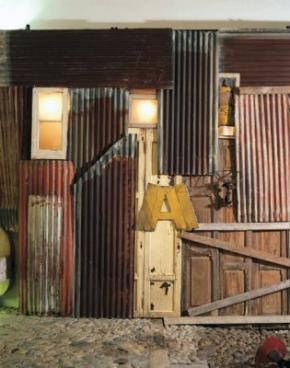 'Na Margem da Zona Limite' (detail), Johannesburg Biennale, 1995But these border are not only comprised out of these walls of corrugated iron and other residual material but also exists as an invisible border in the imagination of the people, who live on both sides of the walls. These people are often border crossers, who have found ways and means to pass these barriers. Here, the border functions as an open contact zone, permeable and changeable. At these crossroads a confrontation of world-views takes place, it is where the cry for freedom had spilled over the walls of the narcissistic colonial empire. On the one side of the skin, that is shown to us by him we find the asphalted streets, the security of colonial architecture, the urban life, a cidade asfaltada. On the other side we find lanes of sand, the vitality of a flexible architecture, which is prepared to change within a single day a terra batida. Walls are nested on top of each other and layered like a palimpsest. In António Oles photography and in his installations we find snapshots of this transient architecture, which constantly change due to its proximity to human life. It has always fascinated him, how fast these modifiable living spaces are changing, that they might be completely nested anew after one week. This view on the ephemeral formations can be found in the photography of the musseques from the 1970s, and it returns thirty years later in his installations.
'Na Margem da Zona Limite' (detail), Johannesburg Biennale, 1995But these border are not only comprised out of these walls of corrugated iron and other residual material but also exists as an invisible border in the imagination of the people, who live on both sides of the walls. These people are often border crossers, who have found ways and means to pass these barriers. Here, the border functions as an open contact zone, permeable and changeable. At these crossroads a confrontation of world-views takes place, it is where the cry for freedom had spilled over the walls of the narcissistic colonial empire. On the one side of the skin, that is shown to us by him we find the asphalted streets, the security of colonial architecture, the urban life, a cidade asfaltada. On the other side we find lanes of sand, the vitality of a flexible architecture, which is prepared to change within a single day a terra batida. Walls are nested on top of each other and layered like a palimpsest. In António Oles photography and in his installations we find snapshots of this transient architecture, which constantly change due to its proximity to human life. It has always fascinated him, how fast these modifiable living spaces are changing, that they might be completely nested anew after one week. This view on the ephemeral formations can be found in the photography of the musseques from the 1970s, and it returns thirty years later in his installations.
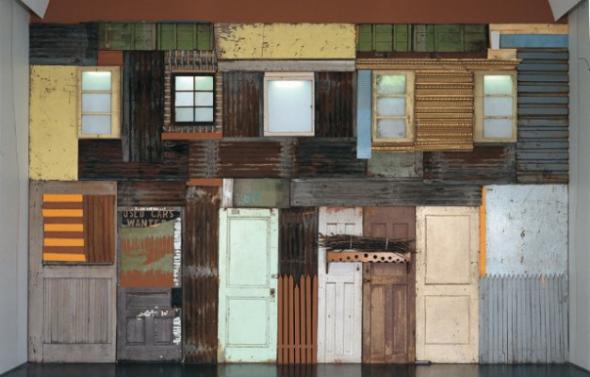 'Township Wall', Chicago, 2001
'Township Wall', Chicago, 2001
Township Wall
In the exhibition one of the famous Township Walls is shown, which he constructed in 2004 in Düsseldorf (Germany). Even if we find relicts of the streets and cities of Germany in this wall, it stands also for all other cities where he build a Township Wall like Chicago (2001), Venice (2003), Lisbon (2004) and Washington (2009). Pictures of these other walls are also shown in the exhibition and reveal the specificity of each and every city. Also in Luanda we find a lot of these brittle walls, loopholes and secret paths hidden in the urban jungle. Behind the borderline of the the asphaltic city we come to then arenaceous peripheries, where exists no roadmap, which you could trust with absolute safety – here the streets always search for new names and courses.
António Ole describes this Township-Wall as one of his most important artworks for himself, because it talks about his artistic development, combining found objects and the bright colours in pop-art style. These aspects are two of the major threads in his work. He went though various stages, used very different media like illustration, painting, photography and film, discovering also the quality of a combination of these in the recent years. While we find a concentration on his large-scale installations in the international exhibitions, António Ole always continued to produce small artworks with simple media like handmade paper and pigments as well. In the exhibition In the Skin of the City we can see both types of work.
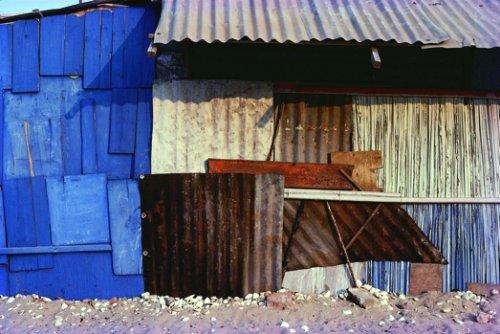 'Casas da Xicala', 1976
'Casas da Xicala', 1976
Photography
António Ole started his artistic career beside painting and illustrations also with the medium of photography in the 1970s. At that time he photographed the people of the musseques of Luanda and their living spaces. In his pictures he tries to find a kind of materialisation of the everyday-life, a conversion into art to show us the vital processes at the side-lines. In these black and white photographies António Ole was able to record these ephemeral moments of decay. The photographies are snapshots from that time of upheaval before and after the independence, when the cry for freedom was unmistakable in Luanda’s streets. In the exhibition we find a black and white picture of a wall and the same wall in a colour photo. António Ole came back to that same place a few years after he took the first picture, and a completely different situation was now offered to him.
Thirty years later he takes a similar look at the walls of dilapidated houses at the peninsula Mussulo, which he converted into four large-scale diptychs (1998). Another step closer he comes in the recent pictures of crumbly walls showing the details of these structures like in the triptych Urban Choices II (2000). The paint is exfoliating and the various layers become apparent. The retarded characters resemble calligraphic signs, partly the flaking colour is an evocation of detaching skin, indeed. In the close-up views the traces on the walls resemble cicatrices on the skin of this city, but also look like a painting that uncovers itself only if we are prepared to take a perspective that might be the one of a salamander.
The triptychs Urban Choices II (2000) and Silent Voices II speak a different language, but also talk about the experience of city life. Urban Choices II is a bright and vivid view on a everyday scene in Luanda. António Ole took this picture on the market Roque Santeiro where one can find everything from monochrome plastic pots to a collection of saints. The other work, Silent Voices II is quite the opposite in its very minimalistic composition. While one can get lost in the details of the former work, it is the striking simplicity of the other one, that invites us to calm down and ponder on that delicate moment right between day and night.
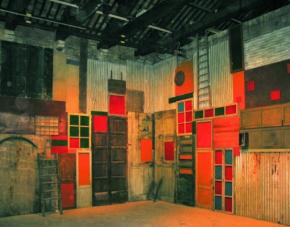 'Township Wall', Venice Biennale, 2003
'Township Wall', Venice Biennale, 2003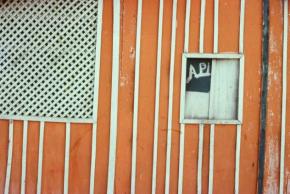 'Sambizanga', 1977
'Sambizanga', 1977
Painting, Collage and Film
A similar perspective can be found in António Ole’s films and paintings. What is most intriguing in all of his artworks is the sense for the combination of form and colour into an aesthetic composition. Whether the source material are found objects from the junkyards or an usual perspective on a ray of light, he is always working towards an equilibrium between the objects.
In the exhibition some stills of the film O Ritmo do Ngola Ritmos are shown, on which we can see a series of doors and windows. Here, António Ole was once more guided by the eye of an architect to look for those places in the city that have exactly this aesthetic quality. Another artwork in the exhibition is the mixed media-piece Rebôco (2001). Here, António Ole combined material like cement, paper and wood together with blue acrylic colour and pigments to an impressive collage. The same fragmented quality can be found in the two collages Personagens e paisagens domésticas revisitadas (2003). For these pieces, António Ole collected segments of walls with rests of acrylic paint and glued them on hand made paper. The result are two fragile pieces that once more are able to express the quality of a cities detaching skin.
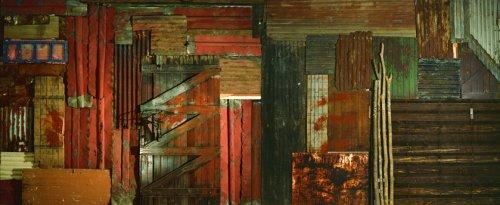 'Na Margem da Zona Limite', Johannesburg Biennale, 1995
'Na Margem da Zona Limite', Johannesburg Biennale, 1995
António Ole tries to combine all these experiences in this exhibition, allowing very different views on the skin of the city. The artworks come from different epochs of producing, but a continuity is apparent: the artistic examination of the border zones, where the cidade asfaltada and the musseques meet each other. The life apart from the asphalted streets is one of the topoi we encounter again and again in António Oles art. He tries to fix the lived moments, before they disappear forever, disposes his very own archive of intimate impressions, that have touched his epidermis. The past has left its traces, corroding through the wounds of the past wars and times of need. It will not be possible to close them as long as they are not healed from inside, completely dried and purged. From this injured epidermis to the inside, this is the way António Ole leads us in his artworks.
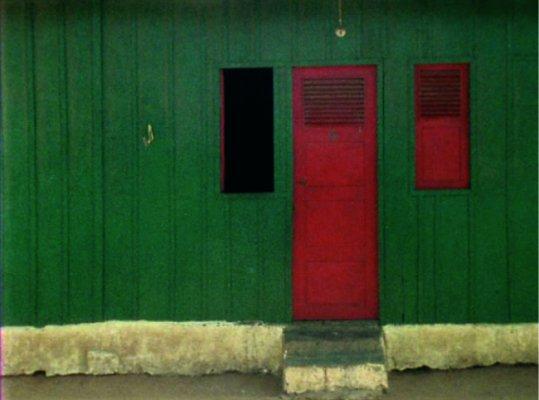 O Ritmo do Ngola Ritmos, film still.
O Ritmo do Ngola Ritmos, film still.
Alex Coles, Site-specificity (Black Dog Publishing, 2000), 58.
Cf. Mary Louise Pratt, Imperial eyes (Routledge, 1992).
Local name for the suburbs that surround Luanda.
Cf. Lisa Saltzman, Making memory matter (University of Chicago Press, 2006), 98.
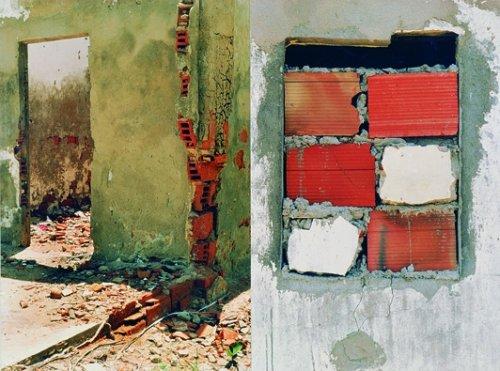 'Sem Título', 1998
'Sem Título', 1998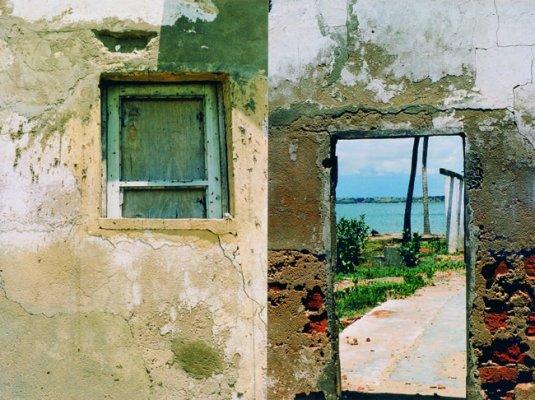 'Sem Título', 1998
'Sem Título', 1998
Artigo originalmente publicado no ARTAFRICA
[1] Alex Coles, Site-specificity (Black Dog Publishing, 2000), 58.
[2] Cf. Mary Louise Pratt, Imperial eyes [Os Olhos do Império] (Routledge, 1992).
[3] Designação local dos subúrbios à volta de Luanda.
[4] Cf. Lisa Saltzman, Making memory matter [Fazer valer a memória] (University of Chicago Press, 2006), 98.